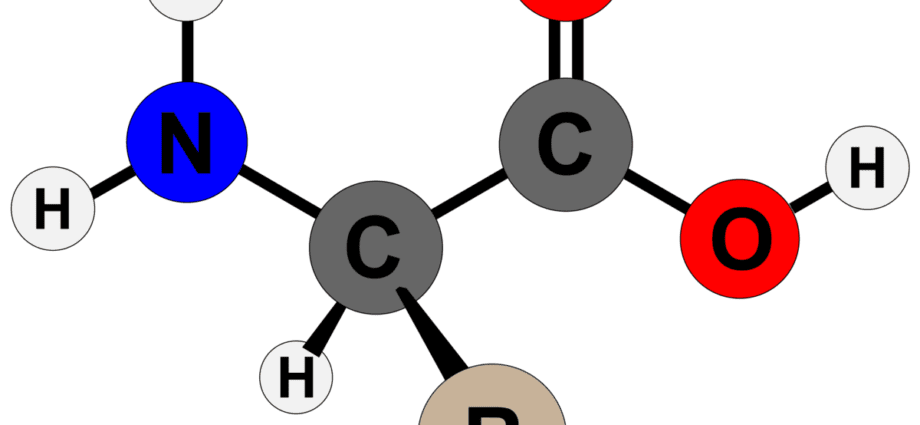Contents
There are about 200 amino acids in nature. 20 of them are found in our food, 10 of them have been recognized as irreplaceable. Amino acids are essential for the proper functioning of our body. They are a part of many protein products, are used as dietary supplements for sports nutrition, they are used to make medicines, they are added to animal feed.
Foods rich in amino acids:
Indicated approximate quantity in 100 g of product
General characteristics of amino acids
Amino acids belong to the class of organic compounds used by the body in the synthesis of hormones, vitamins, pigments and purine bases. Proteins are made of amino acids. Plants and most microorganisms are able to synthesize all the amino acids they need for life on their own, unlike animals and humans. A number of amino acids our body is able to receive only from food.
Essential amino acids include: valine, leucine, isoleucine, threonine, lysine, methionine, phenylalanine, arginine, histidine, tryptophan.
The replaceable amino acids produced by our body are glycine, proline, alanine, cysteine, serine, asparagine, aspartate, glutamine, glutamate, tyrosine.
Although this classification of amino acids is very arbitrary. After all, histidine, arginine, for example, is synthesized in the human body, but not always in sufficient quantities. The replaceable amino acid tyrosine can become indispensable if there is a lack of phenylalanine in the body.
Daily need for amino acids
Depending on the type of amino acid, its daily requirement for the body is determined. The total body need for amino acids, recorded in dietary tables, is from 0,5 to 2 grams per day.
The need for amino acids is increasing:
- during the period of active growth of the body;
- during active professional sports;
- during the period of intense physical and mental stress;
- during illness and during recovery.
The need for amino acids decreases:
With congenital disorders associated with the absorption of amino acids. In this case, some protein substances can cause allergic reactions in the body, including problems with the gastrointestinal tract, itching and nausea.
Amino acid assimilation
The speed and completeness of assimilation of amino acids depends on the type of products containing them. Amino acids contained in egg whites, low-fat cottage cheese, lean meat and fish are well absorbed by the body.
Amino acids are also quickly absorbed with the right combination of products: milk is combined with buckwheat porridge and white bread, all kinds of flour products with meat and cottage cheese.
Useful properties of amino acids, their effect on the body
Each amino acid has its own effect on the body. So methionine is especially important for improving fat metabolism in the body, it is used as the prevention of atherosclerosis, cirrhosis and fatty degeneration of the liver.
For certain neuropsychiatric diseases, glutamine, aminobutyric acids are used. Glutamic acid is also used in cooking as a flavoring agent. Cysteine is indicated for eye diseases.
The three main amino acids, tryptophan, lysine and methionine, are especially needed by our body. Tryptophan is used to accelerate the growth and development of the body, and it also maintains nitrogen balance in the body.
Lysine ensures the normal growth of the body, participates in the processes of blood formation.
The main sources of lysine and methionine are cottage cheese, beef, and some types of fish (cod, pike perch, herring). Tryptophan is found in optimal amounts in organ meats, veal and game.
Interaction with essential elements
All amino acids are water soluble. Interact with vitamins of group B, A, E, C and some microelements; participate in the formation of serotonin, melanin, adrenaline, norepinephrine and some other hormones.
Signs of a lack and excess of amino acids
Signs of a lack of amino acids in the body:
- loss of appetite or decreased appetite;
- weakness, drowsiness;
- delayed growth and development;
- hair loss;
- deterioration of the skin;
- anemia;
- poor resistance to infections.
Signs of an excess of certain amino acids in the body:
- disorders in the thyroid gland, hypertension – occur with an excess of tyrosine;
- early gray hair, joint diseases, aortic aneurysm can be caused by an excess of the amino acid histidine in the body;
- methionine increases the risk of stroke and heart attack.
Such problems can arise only if the body lacks vitamins B, A, E, C and selenium. If these nutrients are contained in the right amount, the excess of amino acids is quickly neutralized, thanks to the transformation of the excess into substances useful for the body.
Factors affecting the content of amino acids in the body
Nutrition, as well as human health, are the determining factors in the amino acid content in an optimal ratio. Lack of certain enzymes, diabetes mellitus, liver damage lead to uncontrolled amino acid levels in the body.
Amino acids for health, vitality and beauty
To successfully build muscle mass in bodybuilding, amino acid complexes consisting of leucine, isoleucine and valine are often used.
Athletes use methionine, glycine, and arginine, or foods containing them, as dietary supplements to maintain energy during exercise.
Anyone who leads an active, healthy lifestyle needs special foods that contain a number of essential amino acids to maintain excellent physical shape, quickly recuperate, burn excess fat or build muscle.
We have collected the most important points about amino acids in this illustration, and we would be grateful if you share the picture on a social network or blog, with a link to this page:










